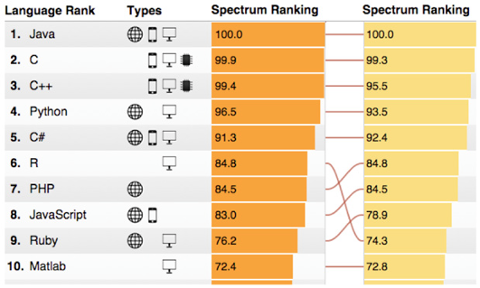Python, C Top Employers' Most In-Demand Programming Languages
Which programming languages are most in-demand among employers? According to an updated ranking by IEEE Spectrum, the usual suspects top the list: Python, C, Java, C++, and C# (in descending order). Although IEEE Spectrum updates this list every year, the 2018 edition is a little bit different thanks to Dice shutting down its API; because of that, Dice data is treated as a null set. The other nine data sources include Stack Overflow, GitHub, CareerBuilder, and the IEEE Xplore Digital Library. (A full breakdown of the methodology is available.)
What differentiates the programming languages at the very top of the list from those below? For starters, they are all established, with long histories, huge install bases, and ample documentation and resources; employers aren’t going to rely on a relatively new or esoteric language for their technology stacks. Second, these top five languages have broad applications across enterprise applications, the Web, mobile, and (in the case of Python, C, and C++) embedded systems. That makes them popular for a range of employers who (obviously) have different strategies and ends, especially in emerging areas such as the Internet of Things (IoT) and the cloud. That’s why languages such as HTML (pretty much Web-only) and Swift (iOS/macOS-only) are relatively low on IEEE Spectrum’s list, despite their widespread use; languages with broader applicability simply have more job postings. Not everyone needs a web page built or an iOS app designed. What does this mean for those hunting for jobs? While mastering new things is exciting, it’s knowledge of the tried-and-true languages that will open up the most opportunities. And once you’ve gotten your foot in the proverbial door, specialization will give your salary a significant boost: according to an analysis of salary data collected for Foote Partners’ IT Skills and Certification Pay Index, skills such as data science, Scala, penetration testing, and Apache Spark will increase your take-home pay by as much as 15 percent.



